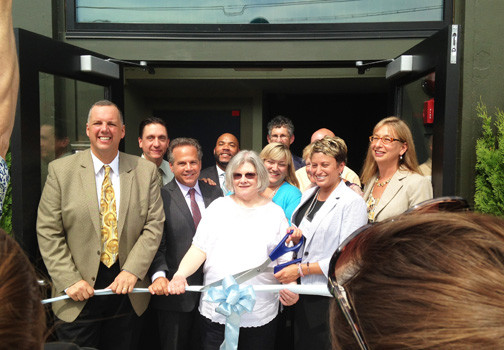Building affordable housing for all those middle-class job holders
The Gately Building renovation, turning a building that had been vacant for more than 20 years into affordable rental units, reflects a common sense development strategy
PAWTUCKET – The Gately Building at 2 Bayley St. stands amidst a maze of downtown buildings and intersections, at the spot where Dexter, Bayles and Main streets collide, a testament to the days when walking downtown city streets connected pedestrians to commerce.
The 101-year old structure, listed on the National Register of Historic Places and noted for its unique “flat iron” shape, had been vacant since 1993. [For architectural connoisseurs, it is considered a “cousin” to the Flat Iron Building in New York City and the Dupont Circle Building in Washington, D.C.]
But it is vacant no more; the Gately Building is now the home to some 35 new affordable rental apartments, all of them spoken for, with FarmFresh Rhode Island serving as a downstairs anchor tenant, as a retail site that will include a worker training and job placement program for entry-level positions in the food industry.
The Gately Building had been home to a long list of businesses over the years, including a hat store, a private library, a candy manufacturer, watchmakers, multiple banks, and the War Department during World War II.
Building artifacts saved during the renovation included a door and a wall directory listing tenants; its second floor had been the office of a dentist, D.L. Savoie, for more than four decades, from 1941 through 1985; it had also served as the office of the Pawtucket bureau for The Providence Journal and The Evening Bulletin, back when the newspaper published an evening edition and also staffed local news bureaus.
Stitching together resources
The act of breathing new life into the building was a complex act of resuscitation involving stitching together a quilt of financing from local banks, tax credits, local community development corporations and federal housing officials. The successful collaboration was celebrated in a ribbon-cutting ceremony on Monday, Aug. 31, with a bevy of officials participating.
They included: Rep. David Cicilline, Pawtucket Mayor Donald Grebien, Barbara Fields, executive director of Rhode Island Housing, Jeanne Cola, executive director of RI LISC, Tony Lyons, the vice president of the National Equity Fund, which helped to fund the project through tax credits, Linda Weisinger, the executive director of the Pawtucket Central Falls Development Corporation, Kenneth Willis, first vice president of the Federal Home Loan Bank of Boston, and Michael Tondra, executive director of the Office of Housing and Community Development at the Housing Resources Commission.
There were lots of local heroes along the 20-year journey to rehabilitate the building, according to the speakers: the Pawtucket Credit Union, RI LISC, which put the first money into the project, Pawtucket Central Falls Development, which will celebrate its 25th anniversary at the Historic Slater Mill on Sept. 17, the National Equity Fund that invested $7 million in tax credits.
Quantifying the need
All of the apartments in the building are already spoken for, a testament to the need for affordable housing in Pawtucket.
The news release for the event cited the HousingWork’s RI Fact Book: out of the 31,979 year-round housing units in Pawtucket, only 2,780 are considered to be long-term affordable.
A market-rate two-bedroom rent in Pawtucket of $1,018 required an annual income of $40,720, meaning most of those apartments are out of reach for those with the median renter household income range of $27,763, according to the news release.
Monthly rents in the Gately Building rate from $600 to $950, plus utilities.
The connection to health
Barbara Fields, the executive director of Rhode Island housing, spoke with ConvergenceRI about the importance of FarmFreshRI being an anchor retail tenant in the newly rehabilitated building, connecting residents with healthy foods and helping young people to get trained in the food industry.
“We all know that Rhode Island is a mecca for great food,” she said. “So, I think that helping people get a skill set in place through which they can actually find jobs is important.”
Fields also stressed the convenience of the new residences. “I like the downtown walkability, to get people out of a car and walking.”
Overall, Fields stressed what she described as the win-win-win nature of the project. “I think it complements what the mayor is trying to do here. It puts construction workers back to work, creating housing construction jobs, and we get affordability.”
Connecting healthy food to healthy communities
Pawtucket Central Falls Development is not alone in its efforts to support the connections between housing and access to healthy food. In the West End of Providence, West Elmwood Development is expanding its Sankofa World Market concept, building some 50 new affordable rental apartments in a $15 million project, the Sankofa Apartments, with some 16,000 square feet of new growing space in community gardens to be developed right next to the apartment development. The goal is to create a source of healthy, affordable foods that reflect the community’s cultural richness. The plans are to create a permanent, year-round indoor site for the Sankofa World Market. [See link to ConvergenceRI story below.]
“We already operate more than 30 community garden plots on 10,000 square feet of formerly vacant lots in the West End,” said Rachel Newman Greene, director of Partnerships and Community Projects at West Elmwood Housing, talking about the efforts to create a healthy, unique urban agricultural community in Providence. “The farm will total nearly 30,000 square feet total in the next year.”






